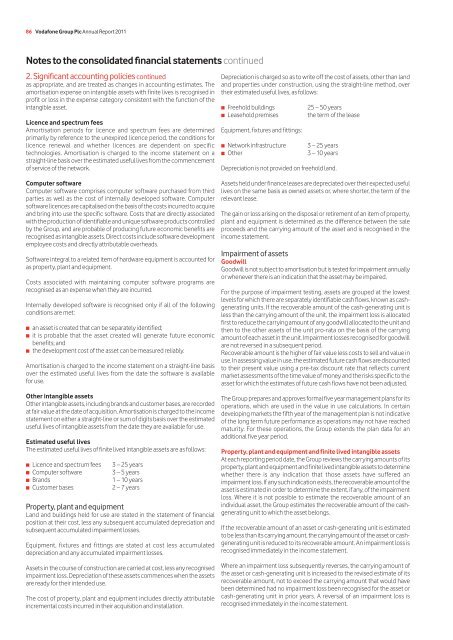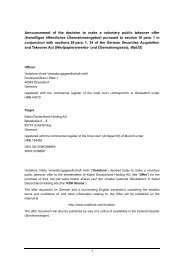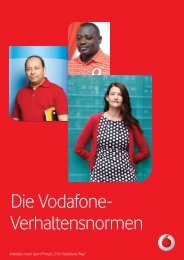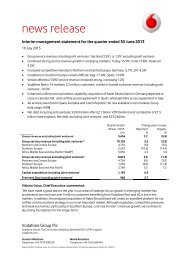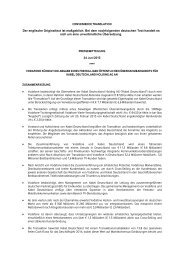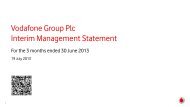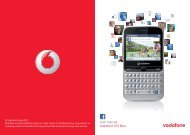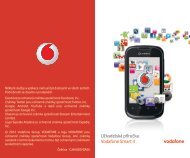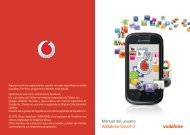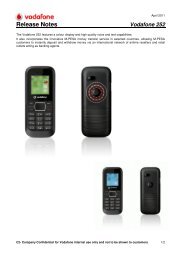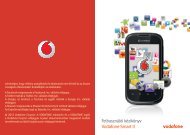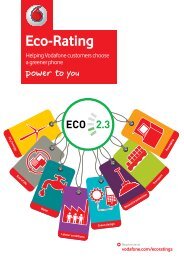Download the report - Vodafone
Download the report - Vodafone
Download the report - Vodafone
Create successful ePaper yourself
Turn your PDF publications into a flip-book with our unique Google optimized e-Paper software.
86 <strong>Vodafone</strong> Group Plc Annual Report 2011<br />
Notes to <strong>the</strong> consolidated financial statements continued<br />
2. Significant accounting policies continued<br />
as appropriate, and are treated as changes in accounting estimates. The<br />
amortisation expense on intangible assets with finite lives is recognised in<br />
profit or loss in <strong>the</strong> expense category consistent with <strong>the</strong> function of <strong>the</strong><br />
intangible asset.<br />
Licence and spectrum fees<br />
Amortisation periods for licence and spectrum fees are determined<br />
primarily by reference to <strong>the</strong> unexpired licence period, <strong>the</strong> conditions for<br />
licence renewal and whe<strong>the</strong>r licences are dependent on specific<br />
technologies. Amortisation is charged to <strong>the</strong> income statement on a<br />
straight-line basis over <strong>the</strong> estimated useful lives from <strong>the</strong> commencement<br />
of service of <strong>the</strong> network.<br />
Computer software<br />
Computer software comprises computer software purchased from third<br />
parties as well as <strong>the</strong> cost of internally developed software. Computer<br />
software licences are capitalised on <strong>the</strong> basis of <strong>the</strong> costs incurred to acquire<br />
and bring into use <strong>the</strong> specific software. Costs that are directly associated<br />
with <strong>the</strong> production of identifiable and unique software products controlled<br />
by <strong>the</strong> Group, and are probable of producing future economic benefits are<br />
recognised as intangible assets. Direct costs include software development<br />
employee costs and directly attributable overheads.<br />
Software integral to a related item of hardware equipment is accounted for<br />
as property, plant and equipment.<br />
Costs associated with maintaining computer software programs are<br />
recognised as an expense when <strong>the</strong>y are incurred.<br />
Internally developed software is recognised only if all of <strong>the</strong> following<br />
conditions are met:<br />
■ an asset is created that can be separately identified;<br />
■ it is probable that <strong>the</strong> asset created will generate future economic<br />
benefits; and<br />
■ <strong>the</strong> development cost of <strong>the</strong> asset can be measured reliably.<br />
Amortisation is charged to <strong>the</strong> income statement on a straight-line basis<br />
over <strong>the</strong> estimated useful lives from <strong>the</strong> date <strong>the</strong> software is available<br />
for use.<br />
O<strong>the</strong>r intangible assets<br />
O<strong>the</strong>r intangible assets, including brands and customer bases, are recorded<br />
at fair value at <strong>the</strong> date of acquisition. Amortisation is charged to <strong>the</strong> income<br />
statement on ei<strong>the</strong>r a straight-line or sum of digits basis over <strong>the</strong> estimated<br />
useful lives of intangible assets from <strong>the</strong> date <strong>the</strong>y are available for use.<br />
Estimated useful lives<br />
The estimated useful lives of finite lived intangible assets are as follows:<br />
■ Licence and spectrum fees 3 – 25 years<br />
■ Computer software 3 – 5 years<br />
■ Brands 1 – 10 years<br />
■ Customer bases 2 – 7 years<br />
Property, plant and equipment<br />
Land and buildings held for use are stated in <strong>the</strong> statement of financial<br />
position at <strong>the</strong>ir cost, less any subsequent accumulated depreciation and<br />
subsequent accumulated impairment losses.<br />
Equipment, fixtures and fittings are stated at cost less accumulated<br />
depreciation and any accumulated impairment losses.<br />
Assets in <strong>the</strong> course of construction are carried at cost, less any recognised<br />
impairment loss. Depreciation of <strong>the</strong>se assets commences when <strong>the</strong> assets<br />
are ready for <strong>the</strong>ir intended use.<br />
The cost of property, plant and equipment includes directly attributable<br />
incremental costs incurred in <strong>the</strong>ir acquisition and installation.<br />
Depreciation is charged so as to write off <strong>the</strong> cost of assets, o<strong>the</strong>r than land<br />
and properties under construction, using <strong>the</strong> straight-line method, over<br />
<strong>the</strong>ir estimated useful lives, as follows:<br />
■ Freehold buildings 25 – 50 years<br />
■ Leasehold premises <strong>the</strong> term of <strong>the</strong> lease<br />
Equipment, fixtures and fittings:<br />
■ Network infrastructure 3 – 25 years<br />
■ O<strong>the</strong>r 3 – 10 years<br />
Depreciation is not provided on freehold land.<br />
Assets held under finance leases are depreciated over <strong>the</strong>ir expected useful<br />
lives on <strong>the</strong> same basis as owned assets or, where shorter, <strong>the</strong> term of <strong>the</strong><br />
relevant lease.<br />
The gain or loss arising on <strong>the</strong> disposal or retirement of an item of property,<br />
plant and equipment is determined as <strong>the</strong> difference between <strong>the</strong> sale<br />
proceeds and <strong>the</strong> carrying amount of <strong>the</strong> asset and is recognised in <strong>the</strong><br />
income statement.<br />
Impairment of assets<br />
Goodwill<br />
Goodwill is not subject to amortisation but is tested for impairment annually<br />
or whenever <strong>the</strong>re is an indication that <strong>the</strong> asset may be impaired.<br />
For <strong>the</strong> purpose of impairment testing, assets are grouped at <strong>the</strong> lowest<br />
levels for which <strong>the</strong>re are separately identifiable cash flows, known as cashgenerating<br />
units. If <strong>the</strong> recoverable amount of <strong>the</strong> cash-generating unit is<br />
less than <strong>the</strong> carrying amount of <strong>the</strong> unit, <strong>the</strong> impairment loss is allocated<br />
first to reduce <strong>the</strong> carrying amount of any goodwill allocated to <strong>the</strong> unit and<br />
<strong>the</strong>n to <strong>the</strong> o<strong>the</strong>r assets of <strong>the</strong> unit pro-rata on <strong>the</strong> basis of <strong>the</strong> carrying<br />
amount of each asset in <strong>the</strong> unit. Impairment losses recognised for goodwill<br />
are not reversed in a subsequent period.<br />
Recoverable amount is <strong>the</strong> higher of fair value less costs to sell and value in<br />
use. In assessing value in use, <strong>the</strong> estimated future cash flows are discounted<br />
to <strong>the</strong>ir present value using a pre-tax discount rate that reflects current<br />
market assessments of <strong>the</strong> time value of money and <strong>the</strong> risks specific to <strong>the</strong><br />
asset for which <strong>the</strong> estimates of future cash flows have not been adjusted.<br />
The Group prepares and approves formal five year management plans for its<br />
operations, which are used in <strong>the</strong> value in use calculations. In certain<br />
developing markets <strong>the</strong> fifth year of <strong>the</strong> management plan is not indicative<br />
of <strong>the</strong> long term future performance as operations may not have reached<br />
maturity. For <strong>the</strong>se operations, <strong>the</strong> Group extends <strong>the</strong> plan data for an<br />
additional five year period.<br />
Property, plant and equipment and finite lived intangible assets<br />
At each <strong>report</strong>ing period date, <strong>the</strong> Group reviews <strong>the</strong> carrying amounts of its<br />
property, plant and equipment and finite lived intangible assets to determine<br />
whe<strong>the</strong>r <strong>the</strong>re is any indication that those assets have suffered an<br />
impairment loss. If any such indication exists, <strong>the</strong> recoverable amount of <strong>the</strong><br />
asset is estimated in order to determine <strong>the</strong> extent, if any, of <strong>the</strong> impairment<br />
loss. Where it is not possible to estimate <strong>the</strong> recoverable amount of an<br />
individual asset, <strong>the</strong> Group estimates <strong>the</strong> recoverable amount of <strong>the</strong> cashgenerating<br />
unit to which <strong>the</strong> asset belongs.<br />
If <strong>the</strong> recoverable amount of an asset or cash-generating unit is estimated<br />
to be less than its carrying amount, <strong>the</strong> carrying amount of <strong>the</strong> asset or cashgenerating<br />
unit is reduced to its recoverable amount. An impairment loss is<br />
recognised immediately in <strong>the</strong> income statement.<br />
Where an impairment loss subsequently reverses, <strong>the</strong> carrying amount of<br />
<strong>the</strong> asset or cash-generating unit is increased to <strong>the</strong> revised estimate of its<br />
recoverable amount, not to exceed <strong>the</strong> carrying amount that would have<br />
been determined had no impairment loss been recognised for <strong>the</strong> asset or<br />
cash-generating unit in prior years. A reversal of an impairment loss is<br />
recognised immediately in <strong>the</strong> income statement.


